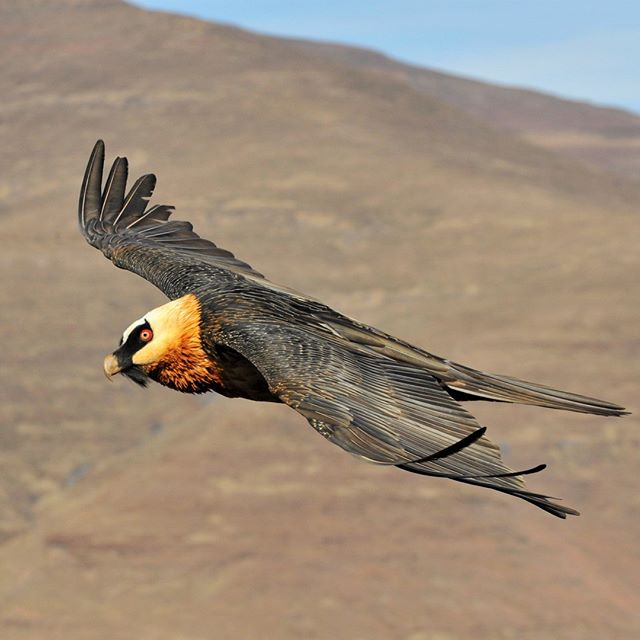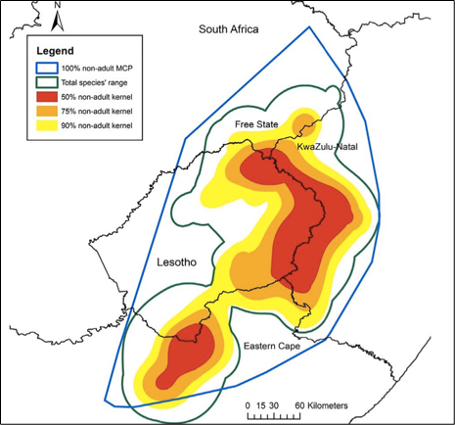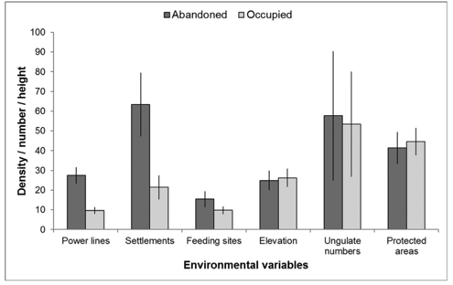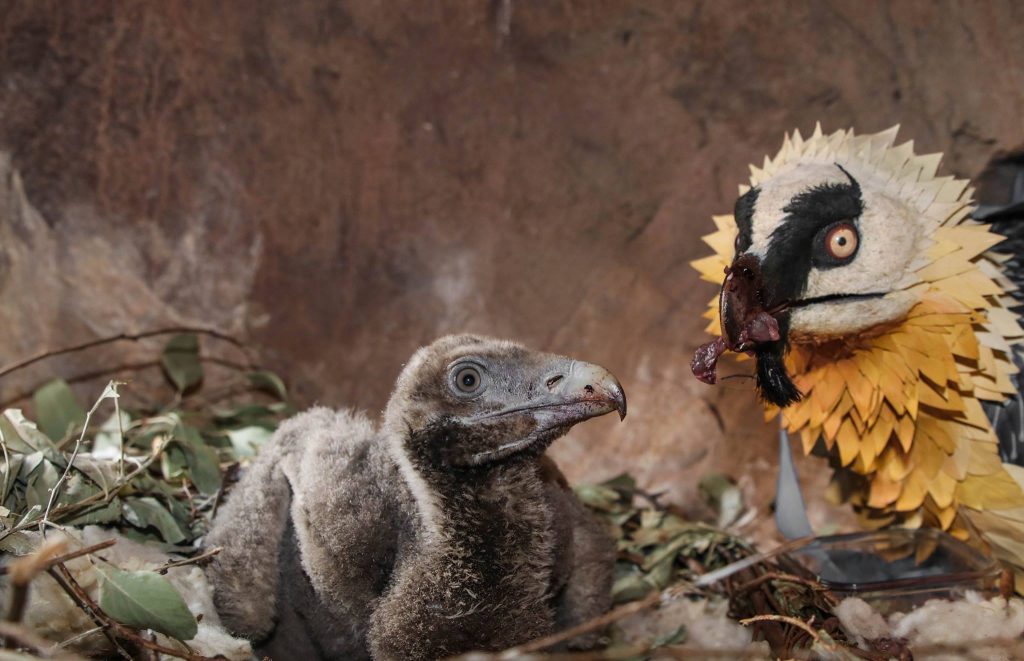
Vulture populations across Africa have undergone massive declines, ‘the African vulture crisis’, mainly as a result of poison use. Similarly, the Bearded Vulture population has declined massively and rapidly in Southern Africa and has now been uplisted to regionally Critically Endangered. This species occupies only 20% of its former distribution range, being now restricted to the Maloti Mountains in Lesotho and adjacent Drakensberg mountains of South Africa.
The authors, Sonja C. Krüger and Arjun Amar, from the Conservation Services Division, Ezemvelo KwaZulu-Natal Wildlife and the FitzPatrick Institute of African Ornithology, both in South Africa, have reviewed 20 years of research on this population of Bearded Vultures. The main objective here was to identify main anthropogenic threats and provide key recommendations for the conservation of this species.
I- Status and main threats to the Southern African population of Bearded Vulture
1-Status of the Bearded Vulture in Southern Africa
Extensive ground and helicopter survey were conducted between 2000 and 2020 to determine the current status and populations trends of this species in Southern Africa. 190 territories were identified of which 109 were still occupied. These results indicated a breeding range reduction of 27% and a decrease of 20% in breeding densities since the first study period (1960-1999). Current population size was estimated at 352-390 individuals (approximately 100 pairs remaining).
2-Characterizing Bearded Vulture movements
Understanding the ranging behaviour of a threatened species and particularly potential individual variations depending on sex, age class or region are crucial to design effective conservation measures. Satellite tags were fitted to 18 Bearded Vultures across four age classes (juvenile, immature, sub-adult and adult).
Adult Bearded Vultures had much smaller home ranges than non-adults. For example, adult average home ranges were 1% the size of the average foraging ranges of non-adults. The three other age-classes (juvenile, immature and sub-adults) used different parts of the overall’s species distribution range but their combined foraging range was 65% of the overall range (see Fig. 2). The authors did not detect any difference in terms of range size and use between sexes in any of the age classes.

Figure 2. Minimum Convex Polygons (MCP) and 50%, 75% and 90% kernel home ranges in Southern Africa showing the total range collectively of non-adults in relation to the overall range for the species. Taken from Krüger SC, Reid T and Amar A (2014b) Differential range use and anthropogenic risk exposure between age classes of Southern African Bearded Vulture s Gypaetus barbatus. PLoS One 9(12): e114920. doi: https://doi.org/10.1371/journal.pone.0114920.
3-Identifying anthropogenic threats to the Bearded Vulture population.
The objectives of subsequent studies were to understand how threats affect different demographic parameters: i.e. productivity and survival in particular and may be responsible for territory abandonment and population decline. Landscape anthropization is the main factor causing territory abandonment and influencing habitat selection, productivity and survival rates.
Territory abandonment
In order to assess the causes of territory abandonment, seven environmental variables linked to human impacts, food availability and climate change were extracted within a 10km radius around each nest. Human impacts had a major effect on territory abandonment with the probability of abandonment being higher for territories with more power lines and a higher density of human settlements (see Fig. 3). There was also evidence for food-limitation to have played a role in territory abandonment within Lesotho, as there was evidence that territories with higher access to supplementary feeding had higher chances of remaining occupied. These results suggested that conservation should aim at limiting landscape anthropization (establishment of new settlements and and power lines) within a radius of 10 km around nests.

Figure 3: Comparison between the average (mean SE) density of human impacts, feeding site proximity, altitude, number of ungulates and percentage of area protected within a 10 km radius around nest sites of abandoned and occupied territories indicating that abandoned sites had a higher density of human impacts, higher feeding site proximity index and lower percentage of area protected. Values have been adjusted for display purposes (settlements x 0.1; feeding sites x 10,000; altitude x 0.1; ungulate numbers x 0.001). Taken from Krüger SC, Wesche PL and Jansen van Vuuren B (2015) Reduced genetic diversity in Bearded Vulture s Gypaetus barbatus in Southern Africa. Ibis 157: 162–166.
Habitat selection and use of adult Bearded Vultures
This study assessed the effects of various topographic and habitat variables on habitat selection of adult Bearded Vultures. The results showed that adults avoided areas with a high proportion of built-up land cover, with the probability of use increasing by 50% at 5km from a built-up area. Breeding adults also selected grasslands and avoided forests. This suggests that in addition to anthropogenic mortality linked to collision with power lines or electrocution, high levels of human settlements may contribute to decreasing foraging habitat quality for Bearded Vultures and therefore precipitate territory abandonment.
Productivity
Poor productivity could theoretically be a factor explaining lower recruitment in vacant territories and therefore their progressive abandonment. Here, the authors showed that only 54% of pairs attempted to breed each year between 2000-2016 and although the nesting success of those pairs was relatively high (0.75 ± 0.22), this resulted in a low productivity of 0.42 ± 0.65 young per pair per year at the population level. Two potential explanations to this low propensity to breed are: i) food limitation although this factor had a limited effect on territory abandonment in previous study, ii) high mortality rates resulting in a high turnover of individuals within pairs, decreasing breeding performance overall.
Causes of mortality
The authors collated all available information on the causes of death of Bearded Vultures (tagged and non-tagged) between 2000-2020. This study found high adult mortality rates, with poisoning alone accounting for 85% of tagged birds found dead (n=13). Eight birds had bone lead levels indicating lead exposure and accumulation over time and lead was very likely the cause of their deaths. Such high mortality rates would have a significant effect on population growth.
Population genetics of the Bearded Vulture
Results of a new article by Streicher et al. 2021 revealed that the southern African population is distinct from other such populations and should thus be managed as a separate entity. In addition, these results revealed high inbreeding in this population and highlighted the need to establish conservation programs in order to conserve the extant of genetic diversity.
II- Identifying management options for the Bearded Vulture population in Southern Africa
1-The viability of the southern African Bearded Vulture population
Using a Population Viability Analysis (PVA), the authors quantified the extinction risk of this population, assessed the factors responsible for such decline and set conservation priorities to address it. As expected, fledglings had the lowest survival estimates (57,14%), followed by subadults aged 3-5 years with survival estimates of between 57.89%–61.29%. Survival rates for adults were very low (around 84%) compared to other raptors with similar life histories. Over 50 years and starting in 2000, model trajectories predicted a 0.89 probability of extinction within 50 years with a l=0.99 (population growth rate). The authors identified that reducing mortality by 40% across all age groups in combination with increasing productivity by 15% and reinforcing the population would achieve a positive growth rate, offering a clear pathway to restore the Southern Bearded Vulture population.
2-A planning tool to inform wind-turbine placement in Southern Africa
Wind-farms can cause vulture mortality and their impacts should be mitigated. Proposals for wind-farms located within the core range of the Bearded Vulture population in Lesotho are concerning. Using movement data, the authors showed that Bearded Vultures are particularly vulnerable to collision with wind turbines and that even small-scale wind-farm development in the Lesotho highlands could precipitate the regional extinction of this species (Rushworth and Krüger, 2014).
The authors also produced an habitat use model to identify intensively used areas and therefore guide the placement of wind turbines away of high-collision risk areas (Reid et al. 2015). They recommended to use an area of protection in a radius of 10 km from nest sites during Environmental Impact Assessments.
3-The use of supplementary feeding sites as a conservation tool
Two studies highlighted potential benefits but also risks associated to the use of supplementary feeding sites in Southern Africa. On one hand, the authors highlighted that the 143 feeding sites provided the equivalent of 83% of all energetic needs of all vultures in the region. However, vultures with small home-ranges like the Bearded Vulture have poor access to such feeding sites (Brink et al. 2020a). On the other hand, few site managers were aware of potential threats affecting vultures at feeding sites like lead contamination of the carcasses or the proximity of the site to power lines. This suggests that vultures including Bearded Vultures may be exposed to anthropogenic threats at feeding sites if they are not managed properly. The flow of information on best management practices should increase between conservation practitioners and site managers in order to improve conservation outcomes of such practices.
4-Captive breeding

A decision was taken in 2015 to establish a captive population to serve as a genetic insurance in case the wild population of Bearded Vultures would go extinct. The program was initiated by harvesting second eggs from the in-situ population. Brink et al. 2020c determined that the best option would be to release four captive-bred young annually (failure probability: 25.5–49.8%). These authors also suggested that despite high mortality rates at the release sites, this reinforcement project would still bear positive effects, as it would reduce the probability of extinction by 30% over a 50-year period. However, this project was delayed by several external factors including limited resources, extreme weather and nest site accessibility and after 6 years, the captive breeding population only comprises 6 individuals.
III- Management recommendations
Addressing the threats
Despite their protected status, vultures have to face poor law enforcement throughout Southern Africa. Therefore, the conservation challenge resides in enforcing legislation throughout the range and making an effective transition from management planning to conservation action on the ground.
The priority to for this Bearded Vulture population is to tackle poisoning risks. In Lesotho, efforts need to focus on addressing the direct poisoning of vultures for traditional medicine or by herders who think that vultures are a threat to their livestock. However, in South Africa, vultures are killed indirectly by poison baits aimed at controlling carnivores. Throughout the range, conservation efforts must focus on (i) finding alternative and effective predator control measures (such as the use of guard animals), (ii) regulating the use of toxicants (agricultural chemicals and pharmaceutical products) known to be lethal to vultures, (iii) law enforcement measures to prosecute perpetrators of poisoning, (iv) outreach programs focused on educating the collectors and users of vulture parts, herders that believe vultures kill stock, and farmers using poisons illegally, and (v) banning hunting and culling with lead ammunition, which is the most likely source of lead in vultures.
A power line mitigation strategy is also in place in South Africa through a partnership between Eskom, the national electricity utility, and the Endangered Wildlife Trust. This partnership is also engaging with the Lesotho Electricity Company to reduce and prevent bird collisions and electrocutions in the country.
Reducing human activities and placing supplementary food close to nest sites (that were shown to influence habitat use and could thus reduce mortality risks for Bearded Vulture s and help fledglings) will also help increasing productivity.
Infrastructure development within the core range of the species should be closely controlled (for example sited in the most appropriate location to minimize negative impacts) and rejected if impacts cannot be adequately mitigated.
Finally, increasing public awareness around the threats to vultures is crucial to engage actors at all levels of society in conservation actions and obtain sufficient economic resources to implement management plans.
Implementation of management plans
A conservation action plan was developed for the species in 2006 by Krüger et al. (2006) in order to develop a species’ management strategy over a 10-year period. The plan was revised in 2011 and a Biodiversity Management Plan for the species was gazetted in South Africa in 2014 to provide a more formal mechanism to achieve the species’ conservation objectives. The 2020 revision of the plan resulted in a Transfrontier Bearded Vulture Recovery Strategy and Action Plan for Southern Africa, aiming to ensure the long-term survival of the species. The Bearded Vulture Task Force is the steering committee of the Recovery Program and is responsible for implementing the strategy and action plan.
Conclusions
The authors have provided here an excellent summary of 20 years of research on the Southern African Bearded Vulture population. These data improved our understanding of current status, distribution, movement ecology, population genetics and factors limiting population growth rate throughout Lesotho and South African. This information is essential to provide evidence-based management guidelines in order to improve conservation actions and reverse the decline of this Bearded Vulture population. At the Vulture Conservation Foundation (VCF), we advocate this approach based on a thorough investigation of the ecology and the main factors threatening the Bearded Vulture and promote the replication of such syntheses in other parts of the Bearded Vulture range.
Source:
Sonja C. Krüger, Arjun Amar. The Ecology and Management of a Critically Endangered Population of Bearded Vulture s. Reference Module in Earth Systems and Environmental Sciences, Elsevier, 2021.
Additional references cited in the review:
Brink CW, Santangeli A, Amar A, et al. (2020a) Quantifying the spatial distribution and trends of supplementary feeding sites in South Africa and their potential contribution to vulture energetic requirements. Animal Conservation, 23(5): 491-501.
Brink CW, Santangeli A, Amar A, et al. (2020b) Perceptions of vulture supplementary feeding site managers and potential hidden risks to avian scavengers. Conservation Science and Practice, 2 (8): e237.
Brink CW, Krüger S, and Amar A (2020c) Potential release sites and strategies for a Bearded Vulture Gypaetus barbatus reintroduction in South Africa. Ostrich, 91(2): 118-128.
Krüger S, Piper S, and Rushworth I, et al. (eds.) (2006) Bearded Vulture (Gypaetus Barbatus Meridionalis) Population and Habitat Viability Assessment Workshop Report. Conservation Breeding Specialist Group (SSC/IUCN)/CBSG Southern Africa. Johannesburg, South Africa: Endangered Wildlife Trust.
Krüger SC, Reid T, and Amar A (2014b) Differential range use and anthropogenic risk exposure between age classes of southern African Bearded Vulture s Gypaetus barbatus. PLoS One 9(12), e114920.
Krüger SC, Wesche PL, and Jansen van Vuuren B (2015) Reduced genetic diversity in Bearded Vulture s Gypaetus barbatus in southern Africa. Ibis 157: 162–166.
Reid T, Krüger S, Whitfield P, and Amar A (2015) Using spatial analyses of Bearded Vulture movements in southern Africa to inform wind turbine placement. Journal of Applied Ecology, 54(4): 881–892.
Rushworth I and Krüger S (2014) Wind farms threaten southern Africa’s cliff-nesting vultures. Ostrich 85(1): 13–23.
Streicher M, Krüger S, Loercher F, and Willows-Munro S (2021) Evidence of genetic structure in the wide-ranging Bearded Vulture (Gypaetus barbatus, (Linnaeus 1758)). BMC Ecology and Evolution 21: 42.



